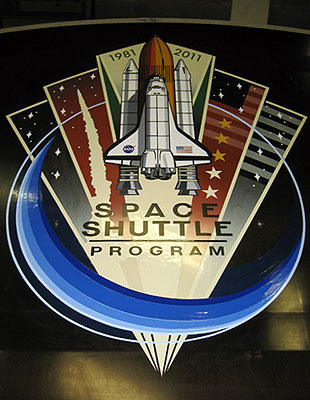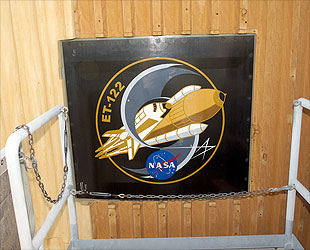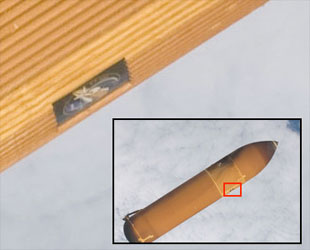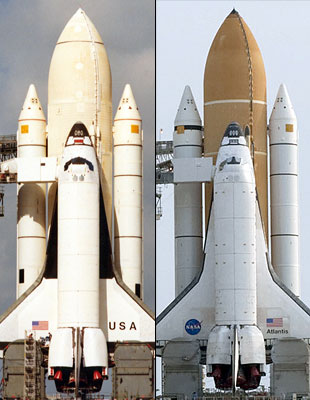The colorful design, which was created and chosen earlier this year through a contest for NASA's past and present employees, has already been reproduced on medallions, embroidered cloth patches and t-shirts — some of which have already flown on board previous shuttle missions. This next and last launch however, will mark its premiere on the side of a spacecraft.
But don't go searching for it just yet; even though space shuttle Atlantis arrived on the launch pad last week, the hand-painted hatch is still waiting to be installed on the fuel tank during the weeks leading up to liftoff, targeted for July 8.
Gem of an emblem

Blake Dumesnil's space shuttle program commemorative logo as hand-painted on the intertank access door. (Lockheed) |
The logo, which was designed by an engineer at NASA's Johnson Space Center in Houston, depicts the shuttle set against a diamond-shaped background.
Artist Blake Dumesnil described his emblem as having been inspired by how the shuttle has been "an innovative, iconic gem in the history of American spaceflight." His insignia's jewel-like facets fan out to "evoke the vastness of space and our aim to explore it, as the shuttle has done successfully for decades."
The logo also evokes an old tagline for the vehicle. When the first shuttle launched in April 1981, it was dubbed "The Gem of the Galaxy."
The central element of Dumesnil's logo, the space shuttle itself, is bounded by panels showing the U.S. flag and two sets of stars: 14 in memory of the astronauts lost aboard orbiters Challenger and Columbia and five symbolizing the shuttle fleet including Discovery, Endeavour and Atlantis.
The emblem's jewel-shape is cradled by the outline of a blue circle, symbolizing the orbiter's realm in Earth orbit but also alluding "to the smoothness of the shuttle orbiting the Earth," according to Dumesnil.
The artwork is finished with the inscription "Space Shuttle Program" and the years that the spaceplanes flew, "1981" through "2011."
Second shuttle 'nose art'
Dumesnil's design was hand-painted onto the 3-foot high by 5-foot wide intertank access door by Lockheed Martin artist Jon Irving at the external tanks' Michoud Assembly Facility in New Orleans.
It was the second fuel tank door that Irving was tasked to paint.
The first, which launched with Endeavour's final flight last month, featured artwork celebrating that tank's repair after being damaged by Hurricane Katrina in 2005.

ET-122's Hurricane Katrina-inspired 'nose art' installed on the side of space shuttle Endeavour's external tank. (NASA) |
John DesForges, Lockheed Martin's manager or "missile mother" for Endeavour's STS-134 tank, ET-122, designed the motivational logo for the company's workforce who were completing the repairs. The art showed the shuttle led by its external tank flying through the eye of the storm.
As a nod to their effort, NASA requested that DesForges' emblem be painted on the tank's graphite-epoxy intertank access door before ET-122 departed Michoud for the Kennedy Space Center in Florida. It was the first time that NASA had authorized an aesthetic change to the external tank since the shuttle's first two tanks were painted all white.
Originally however, ET-122 wasn't expected to fly; instead it was assigned to stand ready to launch Atlantis should Endeavour's crew need rescuing. Congress then approved the funding for the "launch-on-need" mission to become the final space shuttle flight, STS-135.
As part of that decision, Endeavour and Atlantis switched tanks. ET-122 fueled Endeavour for the next-to-last flight and external tank 138 (ET-138) was mated with Atlantis to fly the last.
One-way door
ET-138 was already in Florida when NASA decided to add Dumesnil's commemorative emblem to the final external tank.
Instead of flying Irving to the Cape and having him paint the logo on the side of the 154-foot high standing tank, he decorated a spare door at Michoud, which was then flown to Kennedy Space Center to be installed out on the launch pad.
Dumesnil's and Irving's art will fly to space with Atlantis on a one-way trip.
Unlike the other parts of the space shuttle, the orbiter and its twin solid rocket boosters, which will be recovered, the external tank will fall back into the atmosphere and break apart under the friction of reentry.
The last time the logo will be seen is when Atlantis' crew turns their cameras back at the tank as it falls away from the orbiter.

Oblique view of ET-122's logo as the external tank falls away from space shuttle Endeavour and back to Earth. (NASA) |
Atlantis will then fly on to the International Space Station, where it will deliver supplies before returning to Earth itself for a planned landing on the morning of July 20.
Launch livery
When Atlantis launches on the STS-135 mission 12 days earlier, it and its launch components will look more or less the same as they did when STS-1 lifted off 30 years ago — with a few key differences in addition to ET-138's 'nose art.'
The first two external tanks were painted white to match the aesthetic of the black and white orbiter and white solid rocket boosters. After STS-2, the paint was omitted to save weight, allowing the shuttle to carry about 600 more pounds to orbit. All the tanks since have flown with their orange-brown insulating foam bare.
The twin solid rocket boosters (SRBs) underwent a minor markings change in 1993. The two boosters that launched the first Hubble Telescope servicing mission replaced an L-shaped marking for a simple black band to discern the left booster from the right after they separated from the orbiter.

Then and now: Space shuttle Columbia (at left) before STS-1 in 1981 and shuttle Atlantis (right) before STS-135 in 2011. (NASA) |
The orbiters themselves went through a livery change in 1998 when the markings on their wings were updated and traded sides.
Up until then, orbiters Challenger, Discovery, Atlantis and Endeavour had the American flag on their left wing and on their right, the 1970's stylized NASA "worm" logo above the orbiter's name (Columbia had the flag on its left wing like the others but only the letters "USA" on its right.)
When Discovery lifted off in October 1998 on STS-95, the mission that saw astronaut John Glenn's return to space, it bore the fleet's new and final configuration: the original NASA "meatball" logo on its left wing and the American flag above the orbiter's name on the right.
